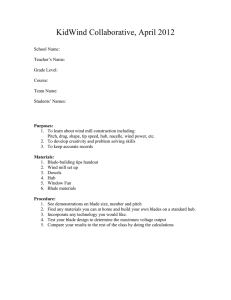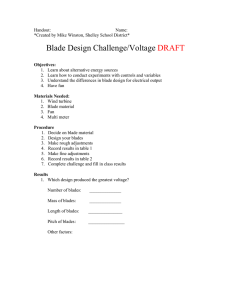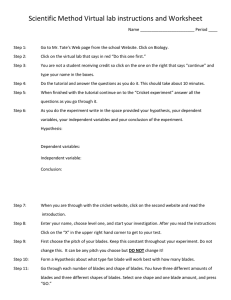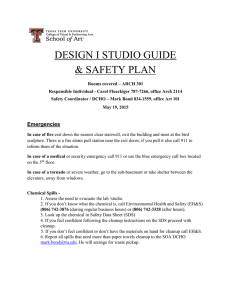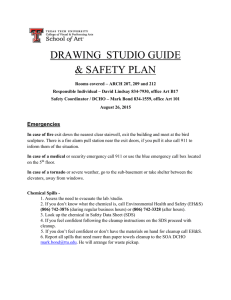Ro ooms Cover red - Art B1 Respo
advertisement
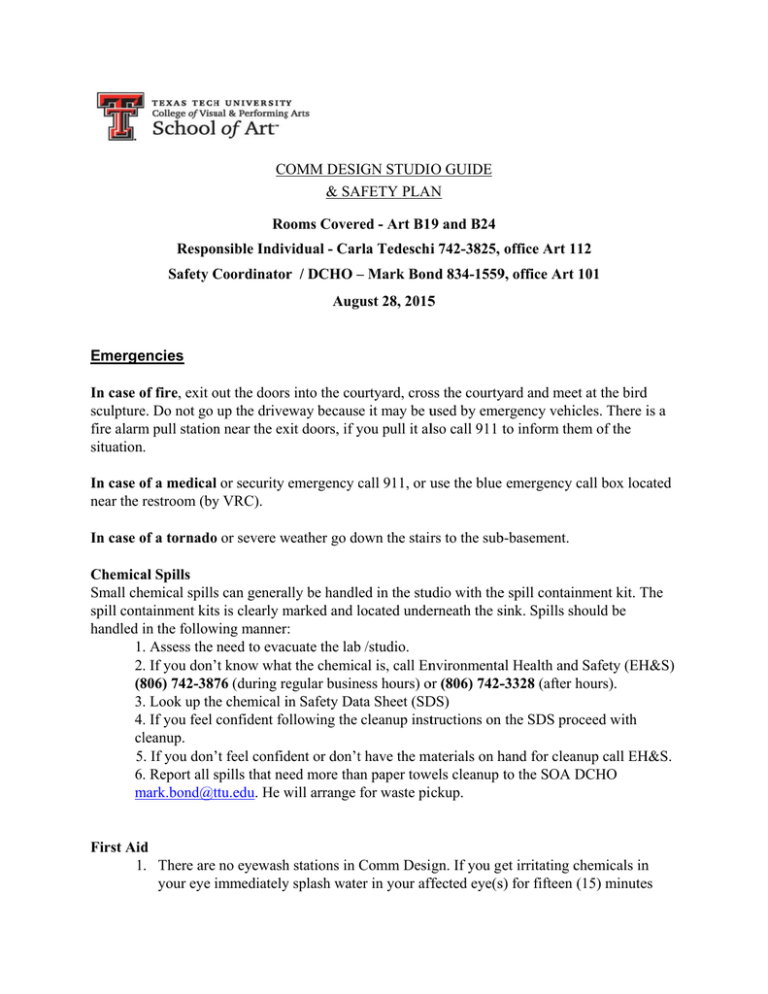
CO OMM DESIIGN STUDI O GUIDE & SA AFETY PLAN AN Ro ooms Coverred - Art B1 9 and B24 Respo onsible Indiv vidual - Carrla Tedeschii 742-3825, office Art 1112 Safety Coordinator C r / DCHO – Mark Bon nd 834-15599, office Art 101 Aug gust 28, 20155 Emerge encies In case of o fire, exit out o the doorss into the cou urtyard, crosss the courtyyard and meeet at the birdd sculpturee. Do not go up the driveeway because it may be uused by emeergency vehiicles. There is a fire alarm m pull station n near the ex xit doors, if you y pull it allso call 911 tto inform thhem of the situation. In case of o a medicall or security emergency call c 911, or uuse the blue emergency call box loccated near the restroom r (by y VRC). In case of o a tornado o or severe weather w go do own the stairrs to the subb-basement. Chemica al Spills Small chemical spillss can generaally be handled in the stuudio with thee spill contaiinment kit. T The spill conttainment kitss is clearly marked m and located l undeerneath the ssink. Spills shhould be handled in i the follow wing manner: 1.. Assess the need to evaccuate the lab b /studio. 2.. If you don’’t know whaat the chemiccal is, call Ennvironmentaal Health andd Safety (EH H&S) (8 806) 742-387 76 (during reegular busin ness hours) oor (806) 742--3328 (after hours). 3.. Look up th he chemical in i Safety Daata Sheet (SD DS) 4.. If you feel confident fo ollowing the cleanup insttructions on the SDS prooceed with clleanup. 5. If you don’’t feel confid dent or don’tt have the m materials on hhand for cleaanup call EH H&S. 6.. Report all spills s that neeed more thaan paper tow wels cleanup to the SOA DCHO mark.bond@t m ttu.edu. He will w arrange for waste pickup. First Aid d 1. There are no eyewash h stations in Comm Desiign. If you geet irritating cchemicals inn your eye immediately i y splash wateer in your afffected eye(ss) for fifteen (15) minutees unless otherwise instructed. If you get foreign matter lodged in your eye (metal, wood, etc.) do NOT rub your eye! Splashing water in your eye may not dislodge something stuck in your eye; you will need to go to the emergency room in that case. 2. The First Aid kits are located in B19 & B24 and are clearly marked. 3. There are two kinds of burns that need attention: a. Minor cuts / burns – can be attended to in the lab/studio. (examples – cuts that are not deep and stop bleeding and burns without large blisters) Minor cuts should be cleaned with antiseptic spray, alcohol wipes, or triple ointment. Cover them with a sterile Band-aid. Minor burns should be immersed in cool (not cold) running water for 15 minutes. Then apply a sterile bandage. Do not apply ice or ointments. If the wound does not heal properly seek medical attention. b. Major cuts / burns - these are deep cuts or burns that will need IMMEDIATE medical attention. (examples – cuts pulsing blood or will not stop bleeding, or more than ¼” deep or with jagged edges. Major burns develop large blisters or char the skin. Major cuts should have pressure applied with a clean compress. Major burns should NOT be immersed in cool water, but covered with a clean compress and held above heart level if possible. In both cases, seek immediate medical attention. When in doubt, always seek professional medical attention – use the blue emergency box or dial 911. The complete Texas Tech University Chemical Hygiene Plan and other helpful documents can be found online at http://www.depts.ttu.edu/ehs/Web/Default.aspx Records of Employee / Student training are located in the School of Art main office. Introduction We at the School of Art endeavor to create a safe, healthy environment for all to work in so they can have a long and productive creative life. The following information will help you achieve these goals. Failure to follow the safety policies and procedures may lead to disciplinary action. Be aware that words such as “water based,” “all natural,” and “organic” or “green” do not indicate the safety of a material. There are many items in nature that are hazardous to humans. Art supplies and materials may be “non-toxic” when “used as directed” but can become hazardous when not used as directed, such as heating, sanding or spraying the material. Personal safety is usually more of an issue when fewer people are around in the evenings and weekends. Always be aware of your surroundings, know who is around you or not, keep your ears open by keeping music low and not using headphones. When working with machinery or hazardous processes always have more than one person present. Do not work when impaired by lack of sleep, illness, drugs or alcohol. All the buildings have combination locks on at least one door, so never prop open exterior doors to help keep unauthorized people out. Classroom doors can remain open during class time and when the room is occupied by an authorized person. Doors must be kept locked when the room is not occupied. General rules All students must have signed the Student Safety Training Form BEFORE they can participate in any hands on studio / lab activities. The Safety Data Sheets for this lab are located in room B24. Chemicals and materials not listed in the Safety Data Sheet yellow binder cannot be stored or used in this studio without the consent of the Responsible Individual and the Safety Data Sheets being added to the SDS binder. Any container other than the original container a chemical comes in is considered a “secondary container.” This includes open containers such as trays. Food or drink containers cannot be reused as secondary containers. All secondary containers (including water), must be labeled according to the OSHA GHS standard. The safety coordinator can answer GHS labeling questions. The RI will provide appropriate secondary containers. Spray adhesives and other spraying cannot be done in these rooms. For approved locations contact your instructor. All flammable liquids and gasses must be stored in a flammable cabinet. There are no flammable cabinets in these classrooms therefore no flammable items may be stored. What you bring in with you must leave with you. NO EXCEPTIONS! All solvents and corrosives must be barcoded into the inventory system by Environmental Health and Safety, including any that are student purchased. For details contact the SOA Safety Coordinator. Procedures that are not listed in the Standard Operating Procedures section cannot be used without consent of the Responsible Individual and until the new procedures have been added to this Safety Plan. Food and drink are allowed in these rooms. Long pants are not required and closed toe shoes are not required in these rooms unless stated in the Standard Operating Procedures. Housekeeping is to be kept up with to provide a safe work space. Aisles and exits are to be kept free of slip, trip and fall hazards. Bench tops are to be free of excess storage and clutter. Extension cords can only be used temporarily and must be picked up at the end of class or work periods. Sharp objects, such as xacto knife blades, utility knife blades and saw blades must be disposed of in an approved “Sharps” container, never the regular trash. Art Installations must be pre-approved by the Safety Coordinator if they involve public spaces. If in doubt, ask first. Never stand on anything other than a ladder or stepstool to increase your reach. Climbing on chairs, stools and tables frequently leads to falls and injuries. Do not hang anything from any pipes or conduit. You may hang objects of less than one pound from suspended ceilings. If you need to hang multiple objects get approval from the Building Manager first. No bicycles, skates, roller blades, skateboards, scooters, etc., are allowed in buildings. Pets and animals are not allowed in buildings. Service animals for persons with disabilities are permitted as long as they are in compliance with section 7 of TTU OP 34.22 Children are not allowed in Studios / Labs without Minors in Laboratory forms filled out and approved in advance. No smoking inside the building or within 20 feet of any doorway. No alcohol or illegal drugs in any Studios / Labs. Wash hands upon leaving the studio. Standard Operating Procedures GENERAL 1. No children allowed without Minor in Laboratory forms filled out and approved in advance 2. No pets allowed 3. No bicycles, skateboards, scooters, roller blades, etc. 4. All personal/secondary containers must be labeled according to the OSHA GHS standard 5. Keep all areas clean. All surfaces should be cleaned after use. 6. 7. 8. 9. All accidents and incidents including minor injuries and all hazardous conditions are to be reported immediately to the instructor and to the safety coordinator. Any equipment, in need of repair should be reported immediately to the instructor and Do not put any paint, glue, or art materials down the sink. Sinks are for hand washing and housekeeping only. All tables are to be sponged down, NOT SWEPT, to clean all dirt and materials off the surface. GLUE 1. Rubber Cement MAY NOT be used under any circumstance or stored in these labs. AIRBORNE SPRAYS 1. Spray adhesives are NOT ALLOWED IN THE CLASSROOMS. NO EXCEPTION. 2. For locations of where spraying is allowed, contact your instructor. X-ACTO KNIVES The most obvious hazard that exists with x-acto knives is the potential for cuts and punctures. These dangers can be minimized by following proper safety rules, recognizing the hazards, and using proper personal protective equipment. 1. Cutting. Using a cutting board or mat placed on a stable surface, grip the handle of the knife with all four fingers and place your thumb on the collar. Always cut away from your body, and be sure others are not in the path if the knife should slip. 2. Storage and Transport. Always store and transport an x-acto knife with a protective cap in place If a cap is not available, lace it in a container that will not leave the blade exposed. BE sure to label the container so others are aware that the knife is inside. Never carry an open x-acto knife in your pocket or place in a pencil holder. 3. Use Only Sharp Blades. Dull, chipped or broken blades require more force to perform the cutting operation safely, and they may slip from the working surface. Change the blade often. If the collar does not open easily for you to remove the old blade, lubricate it with penetrating oil, wait 30 minutes and try again. If it remains stuck, pad the collar and gently apply force with a pair of pliers. Once the collar is free, carefully remove the old blade (be sure to wear heavy duty leather or metal mesh gloves specifically designed for working with sharp objects), slide the new blade into position, and tighten the collar. Wipe off any remaining oil so that the knife will not slip in your hands, Test the collar to make sure that the blade is secure. 4. Disposal of Old Blades. Dispose of old blades by placing them in the sharps container located by the sink. Never throw them in the trash. COMPUTERS 1. Muscle soreness, eye fatigue, and other discomforts and injuries sometimes associated with using computers can occur from performing any number of activities. In fact, misuse of the same muscles during multiple activities can create a problem that might not otherwise exist. Some individuals are at greater risk of developing these problems because of their health, physiology, life-style, and general exposure to stress. Preventing health problems is a multifaceted task that requires careful attention to a variety of conditions. 2. Carpal Tunnel Syndrome is a hand disorder resulting from repetitious motion of the hands and wrist. Carpal tunnel syndrome is often preventable through proper hand positioning and hand exercises. The carpal tunnel is the bony cavity in the wrist through which nerves and tendons extend to the hand. When the same hand movement is repeated day in and day out, and when wrists are bent for long periods of time, the excess strain causes tendons to swell and press on the main nerve of the hand. This persistent irritation of the nerve can result in pain, numbness, and dysfunction not only in the hands and wrists, but may extend up to the forearm and elbow as well. The pain can become incapacitating, so it is important to prevent it from happening in the first place. 3. Take frequent short breaks (every half hour at least) to give muscles and eyes a chance to rest. 4. Eye muscles must work harder to focus on nearby objects. Occasionally focus on a distant object, and blink often while working. 5. Adjust the chair if possible to the proper position, comfortable support is the best, thighs should be horizontal to the floor and feet should be flat on the floor. 6. When using the computer keyboard, shoulders should be relaxed. Upper arm and forearm should form an approximate right angle, with your wrist and hand in roughly a straight line (this will place less pressure on the tendons and nerves in the hand.) Use a light touch when typing or using a mouse and keep hands and fingers relaxed. 6. Position the mouse at the same height as the keyboard. Allow adequate space to use the mouse comfortably. Wrists and hands should be kept in a straight line when using the mouse. 7. If chronic pain or discomfort in the hands, wrists or arms begins to develop, consult a qualified health professional
